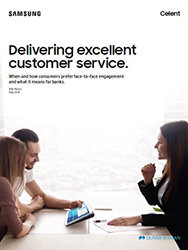Very few things in life are more personal than your money. For a long time, it was simply accepted fact that customers wanted to perform banking transactions face to face, even when telephone and drive-through banking were introduced.
As the internet took root and mobile-native millennials came of age, the landscape changed. Remote and self-serve capabilities became table stakes. Now, after investing heavily in digital banking technology, many financial institutions are wondering — is the branch becoming a relic of the past?
As it turns out, the answer is both yes and no.
The branch can be an asset — or a liability
No, customers are not giving up branches altogether. They still prefer physical locations for certain transactions, particularly those that require long conversations. As you might expect, banking customers over age 60 are the most branch-centric, according to a recent Celent report. But even a sweeping 93 percent of millennials want to visit a branch for at least some matters.
The flip side of the coin is that, to remain viable as we move into the future of banking, branches need to modernize. Financial institutions that take a 1990s approach to branch banking technology will risk high customer churn rates as consumers struggle to find a good reason to pledge their loyalty to any one bank over another.
Within the omnichannel experience that customers now expect, the branch represents the preferred channel for setting up new checking accounts. But there is some risk every time a customer visits a branch. Celent found that, second only to excessive fees, a poor branch experience is the most common reason consumers switch banks. Even a single bad experience is enough to cause churn — particularly among millennials. In fact, mobile banking users are highly sensitive to the customer service they receive in the branch. So what does a positive branch experience look like?
What customers want
Celent discovered that customers value interacting with knowledgeable staff — in a convenient setting and with minimal wait — more highly than other criteria when visiting a branch. These attributes are even more important to high-income consumers who are less forgiving of staff incompetence and long wait times.
At too many branches, customers are forced to either speak with less-knowledgeable staff members or wait to meet with the banking professional they need. This isn’t the bank staff’s fault — it’s a logistical issue. Less than one in five banks offer digital appointment booking for branch visits, and most do not have visibility into the average wait time for these more specialized visits. Moreover, many banks still do not have any automated processes for generating loans applications, still relying on paper applications that tie bank staff up rather than speeding the transaction.
Creating Personalized Customer Experiences
Get your free guide to when, how and why consumers want face-to-face interaction with their banks. Download Now
Only 13 percent of banks have tablet-based applications for front-line staff, so most bankers remain tethered to desktops. That means they have to take customers back to their office and tie up additional time, even to answer simple questions.
To enable the branch experience that customers want, banks need to enable their staff with the right technology to deliver it.
Transforming banking technology
It’s vital that banks rethink the branch experience in light of customers’ desires for knowledge, convenience and short wait times.
The future of banking demands a transformative approach to the branch experience:
-
Staff must be mobile. Desktop devices still have their place in the branch experience, but staff must first and foremost operate on mobile devices. This frees them to engage with customers in the lobby and answer quick questions without having to move the conversation to the office and lengthen the total time of the encounter.
-
Branches must have more sophisticated customer service capabilities. Once staff are mobile, they should be equipped with systems that give them relevant customer information and context-sensitive prompts to help them deliver the best and smoothest experience possible. Additionally, customers should be given the ability to schedule appointments and initiate loan applications and other information-intensive processes digitally from their home or the lobby so that their time with the banker is kept to a minimum.
-
The experience must be measurable. Branch leadership needs the ability to measure average wait times and the customer experience as a whole in order to improve where needed. Without metrics, optimization will always be difficult.
Shifting investments in banking technology
If you’ve been paying attention over the last 20 years, you already know that investing in the customer experience is a never-ending pursuit. The great news is the investments you’ve already made in digital channels will dovetail with branch office technology enhancements to reduce churn and improve loyalty.
So, is the branch dying? No — it’s being reborn. But each bank must adapt to survive the transition.
Looking for more exciting technology for the finance world? Explore our full line of FinTech solutions.









